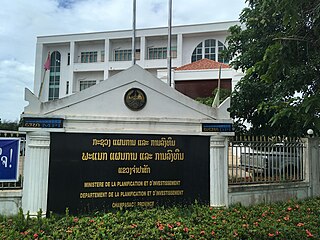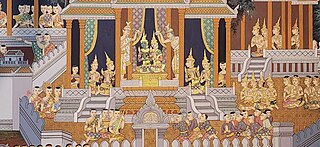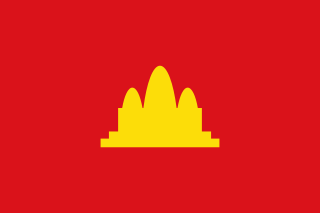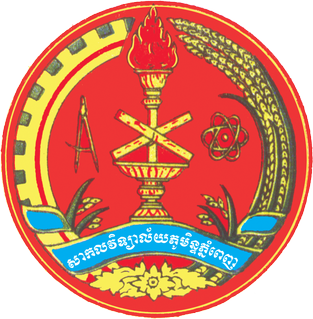
Phnom Penh is the capital and most populous city of Cambodia. It has been the national capital since the French protectorate of Cambodia and has grown to become the nation's primate city and its economic, industrial, and cultural centre. Before Phnom Penh became capital city, Oudong was the capital of the country.

Cambodia, officially the Kingdom of Cambodia, is a country in Mainland Southeast Asia, spanning an area of 181,035 square kilometres, bordered by Thailand to the northwest, Laos to the north, Vietnam to the east, and the Gulf of Thailand to the southwest. The capital and most populous city is Phnom Penh.

The French protectorate of Cambodia refers to the Kingdom of Cambodia when it was a French protectorate within French Indochina, a collection of Southeast Asian protectorates within the French colonial empire. The protectorate was established in 1863 when the Cambodian King Norodom requested the establishment of a French protectorate over his country, meanwhile Siam renounced suzerainty over Cambodia and officially recognised the French protectorate on Cambodia.

The Kingdom of Cambodia, also known as the First Kingdom of Cambodia, and commonly referred to as the Sangkum period, refers to Norodom Sihanouk's first administration of Cambodia from 1953 to 1970, an especially significant time in the country's history. Sihanouk continues to be one of the most controversial figures in Southeast Asia's turbulent and often tragic postwar history. From 1955 until 1970, Sihanouk's Sangkum was the sole legal party in Cambodia.
French was the official language of Vietnam under French colonial rule during the 19th and early 20th centuries. After 1954, French fell into disuse in North Vietnam, and maintained a high status in South Vietnam. Since the Fall of Saigon in 1975, French has declined in modern Vietnam: in 2018, slightly under 1% of the population was fluent in French.
Cambodians in France consist of ethnic Khmer people who were born in or immigrated to France. The population as of 2020 was estimated to be about 80,000 making the community one of the largest in the Cambodian diaspora. The Cambodian population in France is the most established outside Southeast Asia, with a presence dating to well before the Vietnam War and subsequent Indochina refugee crisis including the horrors of Pol Pot and the Khmer Rouge who took over in Phnom Penh on 17 April 1975. A few numbers of Cambodian people were able to escape and migrate to France before the Khmer Rouge took power in Cambodia as the Cambodian Civil War came to an end and overthrow U.S.-backed military dictatorship of Lon Nol and the Khmer Republic. His brother Lon Non and the other Khmer officials were arrested and executed by the CPK, the Marxist-Leninist dictatorship that seized power in Phnom Penh. 13 days before the Fall of Saigon and the Second Indochina War ended on 30 April 1975.

French is spoken by a significant minority in Laos. Laos has the second largest Francophone community in Southeast Asia after Vietnam and ahead of Cambodia. French is used as an administrative language and is also widely present in commerce, and is also studied by over a third of students in Laos. Consequently, the language enjoys a healthier status in Laos compared to other Francophone Southeast Asian countries, although its influence is still under threat from the encroaching use of English.

The largest of the ethnic groups in Cambodia are the Khmer, who comprise 95.8% of the total population and primarily inhabit the lowland Mekong subregion and the central plains. The Khmer historically have lived near the lower Mekong River in a contiguous arc that runs from the southern Khorat Plateau where modern-day Thailand, Laos and Cambodia meet in the northeast, stretching southwest through the lands surrounding Tonle Sap lake to the Cardamom Mountains, then continues back southeast to the mouth of the Mekong River in southeastern Vietnam.

Media in Cambodia is largely unregulated and includes radio, television and print media outlets. Private sector companies have moved into the media sector, which represents a change from years of state-run broadcasting and publishing.

Kampuchea, officially Democratic Kampuchea (DK) from 1976 onward, was the Cambodian state from 1975 to 1979, under the totalitarian dictatorship of Pol Pot and the Communist Party of Kampuchea (CPK), commonly known as the Khmer Rouge (KR). It was established following the Khmer Rouge's capture of the capital Phnom Penh, effectively ending the United States-backed Khmer Republic of Lon Nol. After Vietnam took Phnom Penh in 1979, it was disestablished in 1982 with the creation of the CGDK in its place.

The Royal University of Phnom Penh is a national research university of Cambodia, located in the Phnom Penh capital. Established in 1960, it is the country's largest university. It hosts around 30,000 students in undergraduate and postgraduate programmes. It offers degrees in fields such as sciences, humanities and social sciences,environment, engineering as well as vocational courses in fields such as information technology, electronics, psychology and tourism. RUPP provides Cambodia's foremost degree-level language programmes through the Institute of Foreign Languages. RUPP has full membership in the ASEAN University Network (AUN).
Lycée Sisowath is a secondary school in Phnom Penh, Cambodia. The school was founded in 1873 as a collège and became a lycée in 1933. It is named after King Sisowath.
The Scout and Guide movement in Cambodia is served by two organizations:

Chau Sen Cocsal, also known as Chhum, was a Cambodian civil servant and politician who served as Prime Minister of Cambodia in 1962 and President of the National Assembly twice, in 1962–1963 and 1966–1968. Chhum was awarded the honorary title "Samdech" in 1993 by King Norodom Sihanouk.
Khin Sok was a Cambodian historian, linguist, literature and arts scholar. He acquired a doctorate of history in Paris, published scientific works, taught as a professor in the Royal University of Phnom Penh and was a member of the Royal Academy of Cambodia. His publications during the second half of the 20th century profoundly contributed to the scientific interpretation of historical sources, literature and the systemic development of the modern Khmer language. As a participant of the Khmerization movement he encouraged the promotion of a culturally independent Cambodia on the basis of enlightened and scholarly education in an international context.

Khmer nationalism is a form of nationalism found in Cambodia, that asserts that Khmers (Cambodians) are a nation and promotes the cultural unity of the Khmer (Cambodian) race.

Wat Vihear Suor is a Theravada Buddhist temple located in Kandal Province, Cambodia. It was built on an older pre-Buddhist cult site belonging to the Angkor era.
Ros Chantrabot is a Khmer novelist, poet, historian and member of the Royal Academy of Cambodia.

Samdech Preah Moha Sangkha Reach Nil Teang or Nil Tieng as it was written during the French protectorate of Cambodia, was the first Supreme Patriarch of Cambodia in the Mahanikaya. He held that position during the reign of three consecutive kings: King Preah Ang Duong, King Norodom, King Sisowath.











